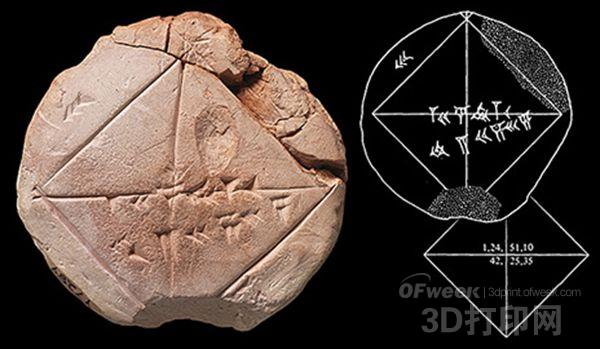Yale 3D printing 3800 years ago Babylon mud board for classroom teaching
About 3,800 years ago, in the hot plains of southern Iraq today, a Babylonian student did a little homework. It was this lesson that changed our understanding of ancient mathematics more than 3,000 years later. The student made a hamburger-sized slab with wet mud and dried it in the sun. In addition, he drew a picture on the surface of the damp earth, proving that as early as the period of the Babylonian period (1900-1700 BC) people had fully understood the "Pythagorean theorem" (rather than the Greek scientist who proposed the theorem) Pythagoras 1300 years ago, and can also calculate the square root of 2 to 6 decimal places. Today, thanks to the Internet and digital scanning technology used in Yale, this ancient geometric mudboard continues to be used in modern classrooms around the world. “This geometric board is one of the most replicated artifacts owned by Yale University – it appears in mathematics textbooks around the world.†Professor Benjamin Foster said he is the manager of the Babylonian Collection. There is this geometric mud in the artefact, which is also a popular teaching tool in Yale class. “Yale’s Babylonian heritage collection has a very active teaching function, and we make education one of the core parts of our mission,†Foster said. “Every week there are groups of graduate and undergraduate students in the collection classroom.†The official name for this slab is YBC 7289, a mathematical document from the Babylonian period, which was donated to JP Yahoo University in 1909 by JP Morgan. The university houses 45,000 artifacts from the ancient kingdom of ancient Mesopotamia, and Morgan's massive donation is the essence. The importance of this geometric slab was first proposed by scientific history experts Otto Neugebauer and Abraham Sachs in their 1945 book, Mathematical Cuneiform Texts. However, today, such precious and fragile artifacts are no longer suitable for daily teaching in the classroom. In order to let more people appreciate the essence of the ancient Babylonian wisdom, the manager of the collection and the culture of Yale The Heritage Protection Institute (IPCH) collaborated to bring these artifacts into the digital world. IPCH's digital laboratory first performed Reflex Imaging (RTI) on 14 objects from the Babylonian collection. RTI is a photographic technique that allows students or researchers to view objects through many different lighting angles. This is especially important for artifacts such as wedge-shaped slabs whose surface is engraved with complex 3D signs. With RTI you can freely control the light and see subtle changes in its surface, which is not possible with ordinary shooting techniques. Chelsea Graham of the IPCH Digital Lab and Yang Ying Yang of Yale Computer Graphics Group subsequently laser scanned the slabs to create a 3D geometric model that can be rotated freely on the screen. This 3D model can be combined with other types of digital imaging technology to present a virtual mudboard for researchers and students on the screen. The same data can also be used to create 3D printed copies, allowing students to use it freely in the classroom. It without worrying about damaging precious artifacts. And the real object that can be held in the hand brings the feeling of the researchers, which is unmatched by the virtual digital model. At present, Yale University's Engineering Innovation and Design Center has cooperated with IPCH on a series of 3D printed artifacts. “Whether it's a statue, a rare skull, or a highly magnified microscopic nerve cell or molecule, you can put its 3D printed model on your hand. This is a very special and important way to understand the data. Researchers are a unique learning experience,†said Joseph Zinter, deputy director of the Engineering Innovation and Design Center. In addition, to help students and researchers share these digital artifacts. IPCH's postdoctoral fellows, Goze Akoglu and Eleni Kotoula, are also working with the school's computer expert Holly Rushmeier to develop an integrated collaborative software platform to support research and sharing of artifacts like the Babylonian mud board. Makeup Blender Brush,Blending Brush,Eyeshadow Blending Brush,Blend Brush DONGGUAN YACAI COSMETICS CO.,LTD. , https://www.yacaicosmetic.com